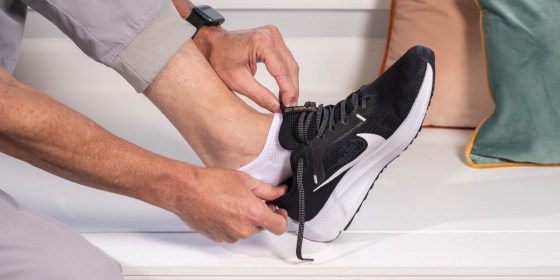Burning, itchy feet? You might have athlete’s foot — here’s how you treat it
Itchy, red, burning feet — you do not have to suffer in silence.


Pinker says he has found this cream effective for many people with athlete’s foot. The active ingredient in this treatment is tolnaftate, which reduces itching and burning while eliminating fungus. Tinactin is available in a cream and a spray.
Another recommendation from Pinker, Lotrimin Ultra, contains the active ingredient butenafine hydrochloride, which alleviates the symptoms of athlete’s foot while also getting rid of the fungus. According to the brand, this cream is greaseless and odorless and won’t stain your socks. This option is a cream that comes in a pen applicator, which means you can rub the pen tip over infected areas without touching the area with your fingers. This can help prevent the spread of the fungus.
This antifungal cream uses another form of hydrochloride (terbinafine hydrochloride) to treat athlete’s foot. Pinker says it is another popular option and should be used twice daily weekly to eliminate athlete’s foot. According to the brand, before applying, wash your feet and then apply a small amount to the infected and surrounding areas.
The spray, which has a 4.5-star average rating from over 3,110 reviews on Amazon, feels cooling as it goes on. This can relieve the burning and itchy sensation caused by athlete’s foot. The active ingredient is tolnaftate, and the spray makes it easy to apply. According to the brand, not only does this spray treat athlete’s food, but you can also use it preventatively.
Rimawi recommends clotrimazole as a great over-the-counter option to treat athlete’s foot and this cream has a 4.4-star average rating from over 1,900 reviews on Amazon. The cream can also be used to treat jock itch and ringworm. Apply this cream twice a day to the infected area for a week.
Anyone can get athlete’s foot, but some people are more prone to it. Take, for example, athletes. It got its name because athletes are more likely to get sweaty feet in their sneakers and are more prone to walking barefoot in a locker room — two things that can lead to this condition.
Beyond athletes, anyone exposed to conditions that lead to warm, moist feet is more likely to deal with athlete’s foot. “People with weakened immune systems may also be more prone to it,” says Rimawi. “Fungi are opportunistic organisms that take advantage of you at your weakest.” Pinker says that those who suffer from hyperhidrosis—meaning they sweat excessively—are also more likely to encounter athlete’s foot. If you tend to sweat, changing your shoes and socks regularly can help.
At NBC Select, we work with experts with specialized knowledge and authority based on relevant training and/or experience. We also ensure all expert advice and recommendations are made independently and without undisclosed financial conflicts of interest.
Bethany Heitman is a contributor at NBC Select and a journalist who regularly covers topics like beauty, home and lifestyle. For this story, she interviewed podiatrists about athlete’s foot.
Catch up on Select’s in-depth coverage of personal finance, tech and tools, wellness and more, and follow us on Facebook, Instagram, Twitter and TikTok to stay up to date.